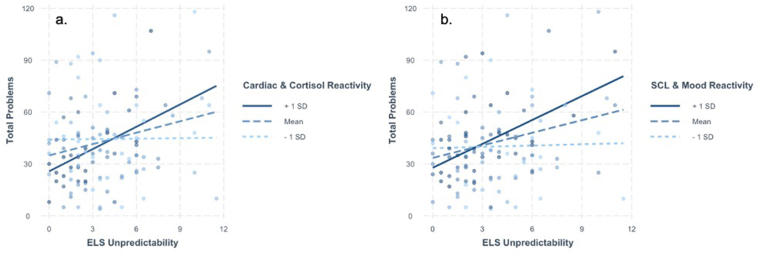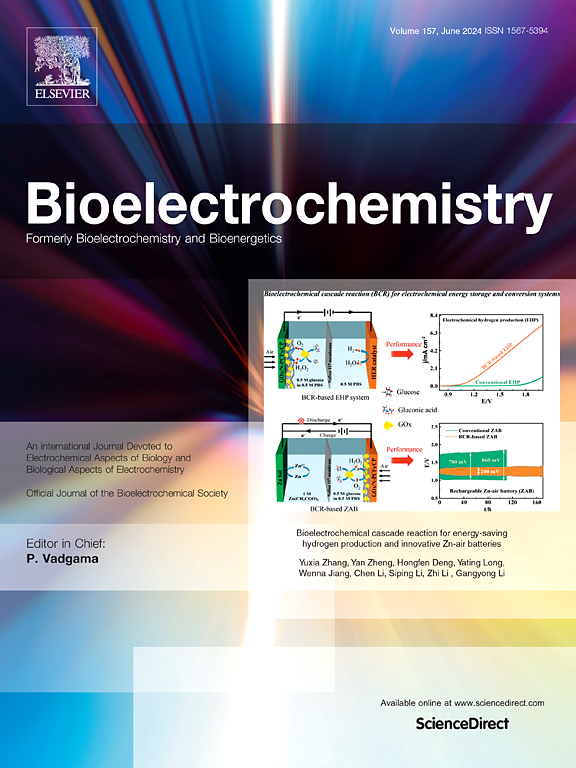Stress reactivity moderates the association between early experiences of unpredictability and emotional problems in adolescents
IF 3.6
2区 医学
Q1 NEUROSCIENCES
引用次数: 0
Abstract
Researchers have documented that exposure to different kinds of psychosocial stressors can lead to emotional difficulties and, further, that heightened reactivity to stress can moderate these associations. Recently, investigators have distinguished among threat, deprivation, and unpredictability as different dimensions of early life stress (ELS). It is not clear, however, whether reactivity in specific stress response systems functions as a diathesis to lead to emotional difficulties following exposure to these dimensions of ELS. In this study (N = 154) we examined whether stress reactivity, assessed across different psychobiological systems during the Trier Social Stress Test, is a unitary or multidimensional construct, and if reactivity differentially moderates the associations between ELS dimensions and adolescents’ susceptibility to emotional and behavioral problems two years later. A factor analysis conducted on stress reactivity measures yielded two factors: one composed of reactivity in heart rate, heart rate variability, and cortisol, and one composed of reactivity in skin conductance and self-reported mood. These two factors independently moderated the associations between early unpredictability and subsequent emotional problems. For each factor, the combination of higher unpredictability and higher stress reactivity predicted higher emotional problems; stress reactivity factors were not significant moderators of the effects of threat and deprivation. Our findings suggest that increased stress reactivity, assessed across several domains of functioning, functions as a diathesis that interacts with ELS characterized by unpredictability to predict subsequent mental health difficulties in adolescents and, further, that low stress reactivity buffers against mental health difficulties in adolescents who have experienced unpredictability early in life.

应激反应缓和了青少年早期不可预测性经历与情绪问题之间的联系。
研究人员已经证明,暴露于不同类型的社会心理压力源会导致情绪困难,而且,对压力的高度反应可以缓和这些关联。最近,研究者区分了威胁、剥夺和不可预测性作为早期生活压力(ELS)的不同维度。然而,目前尚不清楚,特定应激反应系统中的反应性是否作为一种素质,在暴露于ELS的这些维度后导致情绪困难。在这项研究中(N = 154),我们考察了在Trier社会压力测试中通过不同的心理生物学系统评估的压力反应性是一个单一的还是多维的结构,以及反应性是否在两年后不同程度地调节ELS维度与青少年对情绪和行为问题的易感性之间的关联。对压力反应性测量进行的因素分析得出了两个因素:一个由心率、心率变异性和皮质醇的反应性组成,另一个由皮肤电导和自我报告情绪的反应性组成。这两个因素独立地调节了早期不可预测性和随后的情绪问题之间的联系。对于每个因素,较高的不可预测性和较高的压力反应性的组合预示着较高的情绪问题;应激反应因素对威胁和剥夺的影响无显著调节作用。我们的研究结果表明,在多个功能领域中,压力反应性的增加作为一种素质,与以不可预测性为特征的ELS相互作用,以预测青少年随后的心理健康困难,此外,低压力反应性缓冲了在生命早期经历不可预测性的青少年的心理健康困难。
本文章由计算机程序翻译,如有差异,请以英文原文为准。
求助全文
约1分钟内获得全文
求助全文
来源期刊

Neurobiology of Stress
Biochemistry, Genetics and Molecular Biology-Biochemistry
CiteScore
9.40
自引率
4.00%
发文量
74
审稿时长
48 days
期刊介绍:
Neurobiology of Stress is a multidisciplinary journal for the publication of original research and review articles on basic, translational and clinical research into stress and related disorders. It will focus on the impact of stress on the brain from cellular to behavioral functions and stress-related neuropsychiatric disorders (such as depression, trauma and anxiety). The translation of basic research findings into real-world applications will be a key aim of the journal.
Basic, translational and clinical research on the following topics as they relate to stress will be covered:
Molecular substrates and cell signaling,
Genetics and epigenetics,
Stress circuitry,
Structural and physiological plasticity,
Developmental Aspects,
Laboratory models of stress,
Neuroinflammation and pathology,
Memory and Cognition,
Motivational Processes,
Fear and Anxiety,
Stress-related neuropsychiatric disorders (including depression, PTSD, substance abuse),
Neuropsychopharmacology.
 求助内容:
求助内容: 应助结果提醒方式:
应助结果提醒方式:


